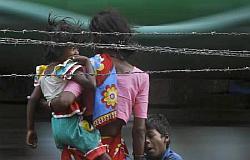India has made significant progress in cutting multidimensional poverty between 1999 and 2006 but at a rate that was less than one-third of the speed of its poorer neighbours like Nepal and Bangladesh, a study by OxfordUniversity has found.
 According to the study, Nepal and Bangladesh are star performers in achieving some of the strongest decreases in poverty in both absolute and relative terms.
According to the study, Nepal and Bangladesh are star performers in achieving some of the strongest decreases in poverty in both absolute and relative terms.
"India also made significant progress between 1999 and 2006, but at a rate that was less than one-third of the speed of its poorer neighbours, with a reduction in poverty rates of 1.2 percentage points per year (instead of 4.1 per cent (Nepal) or 3.2 per cent (Bangladesh)," the study found.
Nonetheless, India reduced multidimensional poverty more than 50 per cent faster than it reduced income poverty in absolute as well as relative terms, the University said in a statement.
"The success of Nepal and Bangladesh in reducing poverty despite their relatively low income highlights the effectiveness of social policy investments combined with active civil society engagement," said Sabina Alkire, Director of the Oxford Poverty and Human Development Initiative (OPHI), the research centre at OxfordUniversity that conducted the study.
The poverty measure used by OPHI, the global Multidimensional Poverty Index (MPI), is unique in capturing the simultaneous disadvantages experienced by poor people, such as malnutrition, education and sanitation, providing a high-resolution lens on their lives.
If people are deprived in a third or more of 10 (weighted) indicators they are identified as 'MPI poor.' Of 22 countries analysed for changes in MPI poverty over
time, Nepal, Rwanda and Bangladesh were found to have made the largest absolute reductions, followed by Ghana, Tanzania, Cambodia and Bolivia.
Most 'top performing' countries reduced MPI poverty as fast or faster than income poverty, with Nepal in particular making stellar progress in cutting both.
According to the study, India, like Nepal, made significant reductions in all ten poverty indicators.
However, multidimensional poverty was reduced least in the poorest states - such as Bihar, Madhya Pradesh, Rajasthan, Uttar Pradesh and West Bengal - and among the poorest social groups, such as Scheduled Tribes, Muslims, female-headed households and larger households.
Moreover, even India's best-performing states - Kerala and Andhra Pradesh - progressed little more than half as fast as Nepal or Bangladesh in reducing multidimensional poverty.
"From 1999-2006 India did very well in certain aspects of poverty reduction; for example, MPI among the scheduled caste groups showed a strong reduction, and poverty among the most destitute went down faster than the average," said Suman Seth, OPHI Researcher.
"However, it's still the case that the benefits of national poverty reduction have been enjoyed least by some of the poorer groups and regions."
Unfortunately, India has not collected official data on MPI deprivations including malnutrition since 2005/6, making India's MPI the least up-to-date in South Asia.
OPHI anticipates being able to update the MPIs for Bangladesh, Pakistan and Afghanistan again in the coming year, all using 2011 data.
The MPI indicators are built from fewer than 40 survey questions, which make up less than 7 per cent of the 600-plus questions present in most Demographic and Health Surveys.
© Copyright 2024 PTI. All rights reserved. Republication or redistribution of PTI content, including by framing or similar means, is expressly prohibited without the prior written consent.

 According to the study, Nepal and Bangladesh are star performers in achieving some of the strongest decreases in poverty in both absolute and relative terms.
According to the study, Nepal and Bangladesh are star performers in achieving some of the strongest decreases in poverty in both absolute and relative terms.